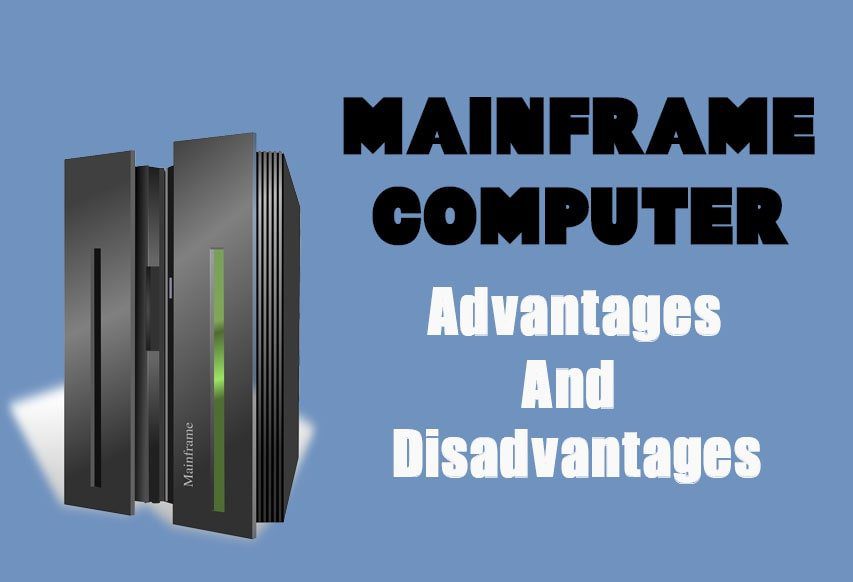The Advantages and Disadvantages of the Mainframe for Your Business

Are mainframe systems dead and buried in the tech sector? Not at all. Many large enterprises are implementing mainframe systems as part of their digital transformation agenda. This might seemingly come across as bad news for modernistic enterprise system developers, but it shouldn’t be that way.
Mainframe systems have their advantages and also disadvantages. Some companies do require the large computing power offered by mainframes. Therefore, the implementation of mainframe solutions is subjective. To help you make an informed decision, here are the advantages and disadvantages of mainframe systems for enterprise solutions.
Security-related pros and cons
The main concern of enterprise system developers is the security of online transactions and collected consumer data. Mainframe systems seemed very appealing to enterprises like banks and even government agencies because of their security. That has not changed. Until this day, mainframe systems remain one of the most secure data computing processing systems. Despite its outward appearance of being outdated, the security of modern mainframes is cutting-edge.
As a result, enterprises that still require the highest level of security on their computing systems utilize mainframes. Despite mainframe modernization by taking this system to the cloud as IaaS solutions, security remains the top priority for administrators, architects, and engineers. Regardless of how you implement mainframe systems, either by administering it yourself or sourcing it as an IaaS, the solution will have high-quality protocols.
High-reliability rate
Digital transformation requires highly reliable systems to function seamlessly with minimal customer dissatisfaction rates. Compared with other computing systems, mainframes have the highest level of reliability. Enterprises implementing mainframe systems internally have ultimate control over the system. As a result, whenever there is a system failure, the administrator and tech support can quickly provide support to fix the problem.
If mainframe systems are maintained and serviced regularly, they can run for longer and have high reliability rates. Even modernized mainframes available as IaaS solutions from cloud-based vendors are highly reliable. Cloud-based IaaS vendors providing modernized mainframes also keep their infrastructure in the best condition. Any service failure caused by downtime is quickly resolved by 24/7 on-site tech support personnel. In either case, mainframes are highly reliable, which is an advantage for enterprise systems.
Are mainframe systems scalable?
Modernistic system engineers might argue that mainframe systems are not scalable when compared with other computing processing systems. It is true that mainframes look quite rigid and hard to scale at first glance. How can you possibly flexibly scale operations with physical computing units? It does not seem flexible at all since you have to buy more hardware when scaling operations. However, when taking a deeper dive into mainframe modernization, it is all about flexible scalability.
Enterprise systems can use only the required amount of computing power and scale up or down with freedom. This makes it easier to scale operations for companies in the supply chain industry using mainframes for their business operations. The supply chain industry and other sectors tend to have seasonal peak traffic. Subsequently, they need mainframe computing power that matches their demand. With modernized mainframes, they can benefit from the scalability of this system.
Increased compatibility
Mainframe systems are advantageous because they are also compatible with a variety of enterprise solutions. Administrators can run a wide variety of operating software on mainframes that are also compatible with running most, if not all, enterprise systems. Compatibility is not an issue, and this is the beauty of mainframe architecture. Even one mainframe unit can run multiple operating systems at the same time. As a result, you can run almost any enterprise system on this type of solution.
It is flexible and can be used to deploy enterprise systems utilizing the latest technologies currently available. The mainframe market is progressively developing, gearing towards being compatible with all enterprise systems. Large market players such as IBM are significantly improving their product offerings which will eventually increase the compatibility to a higher degree.
Mainframe affordability
Contrary to popular belief, mainframe systems can be very affordable when planned and implemented using cost-effective methods. One thing that increases mainframe pricing is the capital required to purchase the hardware and set it up. Additionally, as time goes on, routine maintenance and servicing are also required. All of these factors impact mainframe affordability. However, with modernized mainframes, the costs are significantly reduced since you do not have hardware on-site.
Instead, the hardware is paid for as a service from IaaS vendors. Enterprises do not have to invest the capital required for purchasing hardware, and also overhead expenses used for maintenance are significantly reduced. To add on top of these benefits making mainframes cost-effective, these systems can also be paid for as a pay-as-you-use service. That improves both scalability and affordability.
Can small businesses use mainframe systems?
In most cases, mainframes are not regarded as computing systems for small businesses. That is mostly due to the high cost of implementing this system, including setup capital and ongoing maintenance expenses. With modernized mainframes, these costs are significantly reduced, making it easier for smaller businesses to utilize this technology.
Setting up a mainframe at your business location also requires large equipment. If you are not going to use it to the fullest, it becomes a loss. With advanced scalability, smaller businesses can also leverage the computing power they need to power their enterprise systems. All of these advantages of mainframe modernization drop down the threshold for implementing this technology. As a result, small businesses can use mainframe systems for their business operations.
Are mainframe solutions still relevant?
The question still remains, are mainframe solutions still relevant or advantageous? A short answer to this question is yes! Mainframe solutions have several high-end functionalities on enterprise systems up until this day. Although the tech has advanced a bit, mainframes provide benefits that attracted enterprise system developers years ago.
With mainframe modernization, it is getting more convenient to implement this solution and even easier to scale operations. At the same time, enterprise system developers benefit from using mainframe solutions since it is cost-effective while delivering high reliability and compatibility. The best part is that mainframes are still progressively developing, and they are yet to reach their peak performance and functionality.






